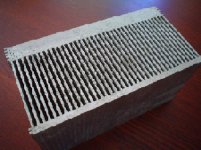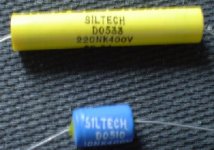SSassen said:Also, it is NOT a DC offset protection, but a DC protection, in case of failure of one of the output transistors etc. to safeguard the attached loudspeakers.
SSassen..
It IS dC offset protection. Whether the offset is 3V or 12V is moot.
Mike,
No, no, I think we both got a different interpretation of the terminology. A DC protection will prevent the load from ever seeing DC due to various reason, ie. someone hooking up a source that outputs DC, or a short in one of the output transistors etc. A DC offset protection implies that it prevents the amplifier's offset from reaching undesired levels, regardless of the input.
Best regards,
Sander Sassen
http://www.hardwareanalysis.com
It IS dC offset protection. Whether the offset is 3V or 12V is moot.
No, no, I think we both got a different interpretation of the terminology. A DC protection will prevent the load from ever seeing DC due to various reason, ie. someone hooking up a source that outputs DC, or a short in one of the output transistors etc. A DC offset protection implies that it prevents the amplifier's offset from reaching undesired levels, regardless of the input.
Best regards,
Sander Sassen
http://www.hardwareanalysis.com
SSassen said:A DC protection will prevent the load from ever seeing DC due to various reason, ie. someone hooking up a source that outputs DC, or a short in one of the output transistors etc. A DC offset protection implies that it prevents the amplifier's offset from reaching undesired levels, regardless of the input.
I suspect you're confusing DC offset compensation or correction with protection.
DC protection and DC offset protection are one and the same thing.
Mike,
We'll just have to agree to disagree on this one I'm afraid, as the very definition of 'DC offset' clearly has a different meaning to you then it has to me. Any more questions? 😉
Best regards,
Sander Sassen
http://www.hardwareanalysis.com
DC protection and DC offset protection are one and the same thing.
We'll just have to agree to disagree on this one I'm afraid, as the very definition of 'DC offset' clearly has a different meaning to you then it has to me. Any more questions? 😉
Best regards,
Sander Sassen
http://www.hardwareanalysis.com
Yo,
Nice amp. I didn't know you worked for Elektor ! Is Denis Meyer still around ?
How does it sound ?
Nice amp. I didn't know you worked for Elektor ! Is Denis Meyer still around ?
How does it sound ?
For Mr Green,
the heatsinks for the ExtremeA, had to wait quite a bit for these to arrive.
Modular sinks, 39 extruded profiles with slots which are pressed together.
The sinks were used to cool huge IGBT's, able to deliver +250 amps each, in welding machines.
Comparable with the heatsinks used by Tom Colangelo in the Viola power amps.
These require a revamp job before mounting them inside a chassis ; a repressing of the extrusions under a professional press, grid blast, accurate grind levelling of the device mounting area and anodising.
Really heavy bricks.
the heatsinks for the ExtremeA, had to wait quite a bit for these to arrive.
Modular sinks, 39 extruded profiles with slots which are pressed together.
The sinks were used to cool huge IGBT's, able to deliver +250 amps each, in welding machines.
Comparable with the heatsinks used by Tom Colangelo in the Viola power amps.
These require a revamp job before mounting them inside a chassis ; a repressing of the extrusions under a professional press, grid blast, accurate grind levelling of the device mounting area and anodising.
Really heavy bricks.
Attachments
jacco vermeulen said:...39 extruded profiles with sloths which are pressed together...
Aren't there laws against that kind of thing? 🙂
Attachments
Strikes back? Oh no.. evolving is the word 😉 Time to try something new now when my Zapsolutes have served me for about ten years.
I want to thank Sander for great service and for quick delivery of the PCB's.
Don't know if I should start my own building thread or not and keep this one for general info and discussion?
One Q though:
I'm about to build the ExtremaA's as separate monoblocks.
I have this idea of building the chassis the way a normal stereoamp is built iow. with one heatsink on each side of the chassi and let the circuitboard bridge the two heatsinks. The heatsinks I have may be a tad to small for one 100W channel so I was thinking that I can mount one outputpair on each sink. Then I realized that this may be a bad idea due to the possibility of a temperature difference between the two sinks which could result in a drift of DC on the output and maybe other problems.
Can someone please comment this?
Thanks in advance!
/Peter, the man formerly known as Pan but who lost his password hence the moniker Pan2
I want to thank Sander for great service and for quick delivery of the PCB's.
Don't know if I should start my own building thread or not and keep this one for general info and discussion?
One Q though:
I'm about to build the ExtremaA's as separate monoblocks.
I have this idea of building the chassis the way a normal stereoamp is built iow. with one heatsink on each side of the chassi and let the circuitboard bridge the two heatsinks. The heatsinks I have may be a tad to small for one 100W channel so I was thinking that I can mount one outputpair on each sink. Then I realized that this may be a bad idea due to the possibility of a temperature difference between the two sinks which could result in a drift of DC on the output and maybe other problems.
Can someone please comment this?
Thanks in advance!
/Peter, the man formerly known as Pan but who lost his password hence the moniker Pan2
SSassen said:Hence input impedance would be 2K2 per input. .
Best regards,
Sander Sassen
http://www.hardwareanalysis.com
Isn't an input impedance of 2k2 a very difficult load for many preamps?
You have not mentioned a word about how it sounds. How about some comparisons with the sound of other amps atleast?
Isn't an input impedance of 2k2 a very difficult load for many preamps?
Yes, for single ended preamps, but since this amplifier is meant for balanced operation where 600-ohm impedances for preamps and line drivers are normal this isn't a problem. Hence driving this amplifier from a single ended (tube) preamplifier that normally likes to drive amplifiers with 47K ~ 100K input impedance isn't going to work well.
You have not mentioned a word about how it sounds. How about some comparisons with the sound of other amps atleast?
I'm not posting here to offer my take on something which is highly subjective, much like anything related to audio. Everybody has their own likes and dislikes regarding this, some like a fair bit of 2nd harmonic (tube sound) others like a THD raising with frequency. This amplifier comes close to the proverbial 'wire with gain' as it offers THD values, even at full output power, that rival that of the CD.
Best regards,
Sander Sassen
http://www.hardwareanalysis.com
Peter,
You answered your own question in the last sentence 😉
Best regards,
Sander Sassen
http://www.hardwareanalysis.com
I have this idea of building the chassis the way a normal stereoamp is built iow. with one heatsink on each side of the chassi and let the circuitboard bridge the two heatsinks. The heatsinks I have may be a tad to small for one 100W channel so I was thinking that I can mount one outputpair on each sink. Then I realized that this may be a bad idea due to the possibility of a temperature difference between the two sinks which could result in a drift of DC on the output and maybe other problems.
You answered your own question in the last sentence 😉
Best regards,
Sander Sassen
http://www.hardwareanalysis.com
SSassen said:
I'm not posting here to offer my take on something which is highly subjective, much like anything related to audio. Everybody has their own likes and dislikes regarding this, some like a fair bit of 2nd harmonic (tube sound) others like a THD raising with frequency. This amplifier comes close to the proverbial 'wire with gain' as it offers THD values, even at full output power, that rival that of the CD.
Best regards,
Sander Sassen
http://www.hardwareanalysis.com
I do understand the subjectivism issue. However, then what is the objective of posting here if not to motivate potential builders/buyers. The price is a little on the higher side for most diyers, though we tend to spend a lot more with various experiments on the way with each project, but my guess is that unless something is said of the sound, this will remain a project of theoretical interest for most here.
SSassen said:[B
ExtremA, a reference class-A DIY amplifier
http://www.hardwareanalysis.com/content/article/1842/
Best regards,
Sander Sassen
http://www.hardwareanalysis.com [/B]
Sorry for me coming to late. My devotion for well designed, low distortion class A is well known. I highly appreciate your design.
Regards,
Pavel
Sam,
Like I said, the 'wire with gain' comment I made earlier is the only comment I'll make regarding its 'sound'. I'm not here to 'sell' a design or PCBs for that matter, the performance figures speak for themselves. esp. to those that know what to look for in a good design.
Best regards,
Sander Sassen
http://www.hardwareanalysis.com
Like I said, the 'wire with gain' comment I made earlier is the only comment I'll make regarding its 'sound'. I'm not here to 'sell' a design or PCBs for that matter, the performance figures speak for themselves. esp. to those that know what to look for in a good design.
Best regards,
Sander Sassen
http://www.hardwareanalysis.com
Sander,
would you be willing to display time domain responses, like 10kHz square, 1dB under full output voltage swing, into different loads, including speaker simulated complex load?
Thanks,
Pavel
would you be willing to display time domain responses, like 10kHz square, 1dB under full output voltage swing, into different loads, including speaker simulated complex load?
Thanks,
Pavel
Craig405 said:Thats a lot of transistors!
The transistor number is not an issue, and Bob Ellis can supply 547C's at a bottom rate.
Compared to exotic matched FET designs, this one gives far less hassle.
Only real hurdle to take for the ExtremeA is the heatsink requirement.
It's a real shame that designs as Bruno/Sander's ExtremeA and the ones by Glenn Kleinschmidt receive so little attention because people are scared off by a few dozen 5 cent small signal transistors.
In time i hope to get an 8 discrete opamp board fully balanced pre-amp design finished, a gift from Peter Schut, a former designer for Sphinx(subsidiary of STC) and Classé.
A pre-amp that i think would mate well with the ExtremeA.
[Siltech(STC) even used to have their own capacitors made for the amplifiers manufactured by their daughter company]
Attachments
jacco vermeulen said:
It's a real shame that designs as Bruno/Sander's ExtremeA and the ones by Glenn Kleinschmidt receive so little attention because people are scared off by a few dozen 5 cent small signal transistors.
I am more inclined to think people are scared off by unpredictable sonic performance. If one is prepared to invest into heatsinks, PS and metalwork a Krell or a Pass clone guarantees some level of sonic bliss.
- Status
- Not open for further replies.
- Home
- Amplifiers
- Solid State
- ExtremA, class-A strikes back?





